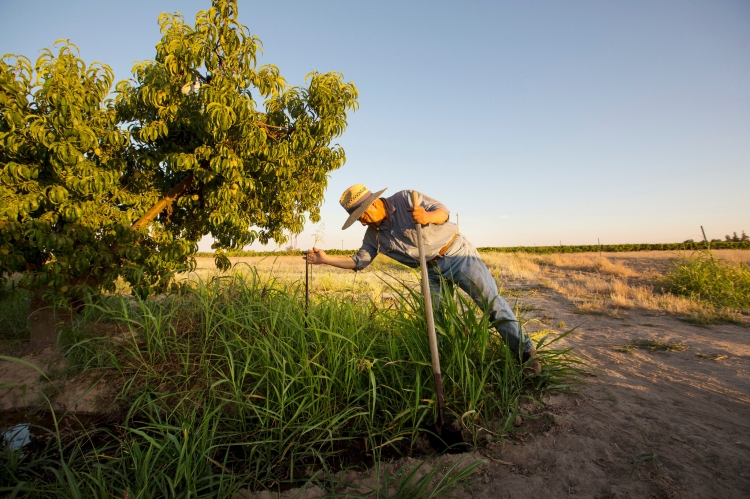
TOMAS OVALLE
How we drained California dry: A story of remaking the land and taking the water until there was nothing left.
Dec 16, 2021 at 5:05pm
The wind finally blew the other way last night and kicked out the smoke from the burning Sierra. Down here in the flatland of California, we used to regard the granite mountain as a place apart, our getaway. But the distance is no more. With all those dead pine trees in thrall to wildfire, the Sierra, transmuted into ash, is right outside our door.
We have learned to watch the sky with an uncanny eye. We measure its peril. Some days, we breathe the worst air in the world. On those few days when we can walk outside without risking harm to our lungs and brains, we greet each other with new benedictions. May the shift in winds prevail, I tell my neighbor. May there be only the dust clouds from the almond harvest to contend with. In the meantime, I don’t dare quiet the turbo on my HEPA filters, hum of this new life.
The most brutal of summers in the San Joaquin Valley has come to a rest at last. Since June, the temperature has broken the 100° mark for 67 days, a new record. Drought won’t let go its grip on the land. Eight of the past 10 years have been ugly dry. This October morning, after a month holed up, I decided to leave my house in the suburbs and roam the middle of California, the irrigated desert at its most supreme. Out in the country, I smell fall in the air. To celebrate its arrival, I’m going to visit an old friend, a farmer named Masumoto, who has 80 acres in Del Rey and is putting the last of his raisins in a box.
There is no way to make this drive out of Fresno at harvest’s end, through the dog-tired fields of the most industrialized farm belt in the world, without thinking about water: the idea of it, the feel of it; the form as it falls from the sky as rain and snow, that man captures with his invention and implementation, his magic and plunder, the dam, the ditch, the canal, the aqueduct, the pump, the drip line; the water that gives rise to every animate and inanimate thing that now stretches before my eyes, the vineyard, orchard, cotton field, and housing tract; the water whose too much can destroy us, whose too little can destroy us, whose perfect measure of our needs becomes our superstition and story.
You should know that I have written about the matter of California and water a few times before, and I’m not above borrowing from old refrains. In my hunt for new words, I have driven Highway 99 a thousand times through a valley that geologists call the most-altered landscape by human hands in history. I now see the gashes of fresh alterations. What has been done here, by any means necessary, has been done for the want of water.
The taking of California was no small project. It relied on the erasure of the most prolific flowering of indigenous people in the United States. The civilization standing in the way was at least 10,000 years in the making and 300,000 strong. They were Yokuts, Maidu, Miwok, Klamath, Pomo, Chumash, and Kumeyaay, to name a few. Looking back at the fevered pace of our footprints over the past 175 years, we tend to idealize the modesty of theirs. And yet it is more than likely true given their numbers, given the bounty and heft of the land, that they did not war with each other over its prize. They lived light on the earth. They moved when nature moved. Flood took them to one place, drought another. When the forest load needed thinning, the fires they set burned brush and lower branch and quickly smothered out.
As genocides go, the wiping clean of California’s indigenous culture was protracted, playing out in three acts: Spanish mission, Mexican occupation, American settlement. The atrocities were only as efficient as the tools of the time—blanket, smallpox, syphilis, torch, knife, Colt .45—allowed. First came the robed Franciscans led by Father Serra, slaver and saint, whose possession of the Indian body gave him the workforce to erect the first crude dams and canals that took rivers to places they’d never been: his 21 missions, from San Diego to Sonoma. At the Mission San Gabriel, the catch of water grew a profusion of grains, vegetables, exotic fruits, and the 170-acre “Las Vina,” mother vineyard.
Next came the dons from Mexico, freed from Spain’s yoke, whose dalliance with California lasted but a quarter-century, from 1821 to 1848. Blending European, Mexican, and American lineages, they called themselves Californios. Rather than tame California’s many states of nature, they amassed millions of acres and tamed themselves. On far-flung rancherias, they slaughtered a calf a day to feast on, drank vast quantities of wine and brandy, and threw royal weddings in which daughters who’d been locked away in finishing schools all their lives finally came out into the sun. In a moment of goodwill, they pledged that the mission lands, and their flow of water, would be turned over to the remaining natives, but the pledge never amounted to a thing.
Continue reading the article from MIT Technology Review here.
